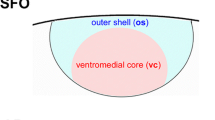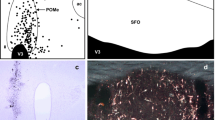Abstract
Immuno-electron-microscopic investigations of cerebrospinal fluid (CSF)-contacting neurons immunoreactive to vasoactive intestinal peptide in the duck lateral septum have revealed that this cell type gives rise to an adventricular dendrite terminating with a bulbous swelling in the lateral ventricle. The swelling bears a cilium and contains mitochondria and immunolabeled dense-core vesicles. Two types of processes emerge from the basal part of the perikaryon. The first has a large diameter, contains diffusely distributed immunoreaction, and receives synaptic input, indicating that this process is a basal dendrite. The other type is of a beaded appearance, displays immunolabeled dense-core vesicles, and represents the axon of the CSF-contacting neuron. VIP-immunoreactive terminal formations are located within the neuropil of the lateral septum and the nucleus accumbens. Some of them form synaptic contacts with immunonegative profiles. No VIP-immunoreactive terminal formations are seen in the perivascular spaces of the lateral septum. Tracer experiments with horseradish peroxidase have revealed that the blood-brain barrier is lacking in the lateral septal organ and nucleus accumbens of the duck. Capillaries, arterioles, and venoles of this region are coated by nonfenestrated endothelial cells connected by “leaky” junctions, allowing the tracer to penetrate from the lumen into the perivascular space and further into the intercellular clefts of the neuropil. Our immuno-electron-microscopic investigations show that VIP-immunoreactive CSF-contacting neurons of the lateral septum closely resemble CSF-contacting neurons occurring in other brain regions, e.g., the hypothalamus. The arrangement of VIP-immunoreactive terminal formations suggests that, in the lateral septum, the VIP-like neuropeptide serves as a neurotransmitter (-modulator). The lack of a blood-brain barrier in the lateral septal organ and the nucleus accumbens raises the possibility that this region is a window in the avian brain allowing exchange of information between the central nervous system and the bloodstream; it thus resembles a circumventricular organ.
Similar content being viewed by others
References
Benoit J (1961) Opto-sexual reflex in the duck: physiological and histological aspects. Yale J Biol Med 34:97–116
Blähser S (1986) The fascinating facets of neuropeptide systems in birds. Acta XIX Congr Internat Ornithol: 2196–2201
Brownstein MJ, Russell JT, Gainer H (1980) Synthesis, transport, and release of posterior pituitary hormones. Science 207:373–378
Card JP, Brecha N, Karten HJ, Moore RY (1981) Immunocytochemical localization of vasoactive intestinal polypeptide-containing cells and electron microscopic analysis. J Neurosci 1:1289–1303
Deguchi T (1981) Rhodopsin-like photosensitivity of isolated chicken pineal gland. Nature 290:206–207
Farner DS (1975) Photoperiodic controls in the secretion of gonadotropins in birds. Am Zool 15 (Suppl) 117–135
Follett BK, Davies DT, Magee V (1975) The rate of testicular development in Japanese quail (Coturnix coturnix japonica) following stimulation of the extraretinal photoreceptor. Experientia 31:48–49
Foster RG, Follett BK, Lythgoe JN (1985) Rhodopsin-like photosensitivity of extra-retinal photoreceptors mediating the photoperiodic response in quail. Nature 313:50–52
Foster RG, Panzica GC, Parry DM, Viglietti-Panzica C (1988) Immunocytochemical studies on the LHRH system of the Japanese quail: influence by photoperiod and aspects of sexual differentiation. Cell Tissue Res 253:327–335
Foster RG, Garcia-Fernandez JM, Provencio I, De Grip WJ (1993) Opsin localization and chromophore retinoids identified within the basal brain of the lizard Anolis carolinensis. J Comp Physiol [A] 172:33–45
Frisch K von (1911) Beiträge zur Physiologie der Pigmentzellen in der Fischhaut. Pfluegers Arch 138:319–387
Fuxe K, Hökfelt T, Said SI, Mutt V (1977) Vasoactive intestinal polypeptide and the nervous system: immunohistochemical evidence for localization in central and peripheral neurons, particularly intracortical neurons of the cerebral cortex. Neurosci Lett 5:241–246
Groos G (1982) The comparative physiology of extraocular photoreception. Experientia (Basel) 38:989–1128
Hirunagi K, Hasegawa M, Vigh B, Vigh-Teichmann I (1992) Immunocytochemical demonstration of serotonin-immunoreactive cerebrospinal fluid-contacting neurons in the paraventricular organ of pigeons and domestic chickens. Prog Brain Res 91:327–330
Hirunagi K, Rommel E, Oksche A, Korf HW (1993) Vasoactive intestinal peptide-immunoreactive cerebrospinal fluid-contacting neurons in the reptilian lateral septum/nucleus accumbens. Cell Tissue Res 274:79–90
Hirunagi K, Kiyoshi K, Adachi A, Hasegawa M, Ebihara S, Korf HW (1994) Electron-microscopic investigation of vasoactive intestinal peptide (VIP)-like immunoreactive terminal formations in the lateral septum of the pigeon (Columba livia). Cell Tissue Res 278:415–418
Hof PR, Dietl MM, Charnay Y, Martin JL, Bouras C, Palacios JM, Magistretti PJ (1991) Vasoactive intestinal peptide binding sites and fibers in the brain of the pigeon Columba livia: An autoradiographic and immunohistochemical study. J Comp Neurol 305:393–411
Korf HW, Fahrenkrug J (1984) Ependymal and neuronal specializations in the lateral ventricle of the Pekin duck, Anas platyrhynchos. Cell Tissue Res 236:217–227
Korf HW, Rommel E, Hirunagi K, Oksche A (1994) Cerebrospinal fluid-contacting neurons: morphological and physiological considerations. In: Pleschka K, Gerstberger R (eds) Integrative and cellular aspects of autonomic functions: temperature and osmoregulation. Libbey, Paris, pp 407–418
Krisch B, Leonhardt H, Oksche A (1987) Compartments in the organum vasculosum laminae terminalis of the rat and their delineation against the outer cerebrospinal fluid-contacting space. Cell Tissue Res 250:331–347
Kuenzel WJ, Blähser S (1994) Vasoactive intestinal polypeptide (VIP)-containing neurons: distribution throughout the brain of the chick (Gallus domesticus) with focus upon the lateral septal organ. Cell Tissue Res 275:91–107
Kuenzel WJ, Van Tienhoven A (1982) Nomenclature and location of avian hypothalamic nuclei and associated circumventricular organs. J Comp Neurol 206:293–313
Leonhardt H (1980) Ependym und Circumventrikuläre Organe. In: Oksche A (ed) Neuroglia I. Handbuch der mikroskopischen Anatomie des Menschen, vol IV/10, Springer, Berlin, pp 177–666
Loren I, Emson PC, Fahrenkrug J, Björklund A, Alumets J, Håkanson R, Sundler F (1979) Distribution of vasoactive intestinal polypeptide in the rat and mouse brain. Neuroscience 4:1953–1976
North WG, Moses AM, Share L (1993) The neurohypophysis: a window on brain function. Ann NY Acad Sci 689:1–701
Oksche A, Hartwig HG (1975) Photoneuroendocrine systems and the third ventricle. In: Knigge KM, Scott DE, Kobayashi H, Ishii S (eds) Brain-endocrine interaction II. The ventricular system in neuroendocrine mechanisms. Karger, Basel, pp 40–53
Oliver J, Baylé JD (1982) Brain photoreceptors for the photoinduced testicular response in birds. Experientia 38:1021–1029
Pelletier G, Leclerc R, Puviani R, Polak JM (1981) Electron immunocytochemistry of vasoactive intestinal peptide (VIP) in the rat brain. Brain Res 210:356–360
Petko M, Ihionvien M (1989) Distribution of substance P, vasoactive intestinal polypeptide and serotonin immunoreactive structures in the central nervous system of the lizard, Lacerta agilis. J Hirnforsch 30:415–423
Priestley JV, Cuello AC (1983) Electron microscopic immunocytochemistry for CNS transmitters and transmitter markers. In: Cuello AC (ed) Immunohistochemistry. Wiley, Chichester New York Brisbane, pp 273–322
Roberts GW, Woodhams PL, Bryant MG, Crow TJ, Bloom SR, Polak JM (1980) VIP in the rat brain: evidence for a major pathway linking the amygdala and hypothalamus via stria terminalis. Histochemistry 65:103–119
Rodríguez EM (1976) The cerebrospinal fluid as a pathway in neuroendocrine integration. J Endocrino 71:407–443
Rodríguez EM, Peña P, Rodríguez S, Aguado LI (1982) Evidence for a participation of the CSF and periventricular structures in certain neuroendocrine mechanisms. Front Horm Res 9:142–158
Rommel E (1987) Populations of cerebrospinal fluid-contacting neurons immunoreactive to vasoactive intestinal polypeptide in the brain of reptiles. In: Scharrer B, Korf HW, Hartwig HG (eds) Functional morphology of neuroendocrine systems. Springer, Berlin, pp 83
Rommel E (1991) Neuronale and vasculäre Spezialisierungen im Nucleus accumbens verschiedener Vertebraten. Thesis, Faculty of Medicine, Justus Liebig University Giessen
Rommel E, Korf HW (1985) Zur Frage der Blut-Hirn-Schranke in Nucleus accumbens. Anat Anz 164:164–159
Said SI (1982) Vasoactive intestinal peptide. Raven Press, New York, pp 1–512
Saidel WM, Kuenzel WJ (1991) A light-(LM) and electron-microscopic (EM) study of vasoactive intestinal polypeptide (VIP) neurons in a circumventricular organ of the chick. Soc Neurosci Abstr 17:971
Silver R, Witkovsky P, Horvath P, Alones V, Barnstable CJ, Lehman MN (1988) Coexpression of opsin-and VIP-like immunoreactivity in CSF-contacting neurons of the avian brain. Cell Tissue Res 253:189–198
Silver R, Ramos C, Machuca H, Silverin B (1992) Immunocytochemical distribution of GnRH in the brain of adult and posthatching great tit Parus major and ring dove Streptopelia roseogrisea. Ornithol Scand 222:232
Sims KB, Hoffman DL, Said SI, Zimmerman EA (1980) Vasoactive intestinal polypeptide (VIP) in mouse and rat brain: an immunocytochemical study. Brain Res 186:165–183
Vigh B, Vigh-Teichmann I (1973) Comparative ultrastructure of the CSF-contacting neuron. Int Rev Cytol 35:189–251
Vigh-Teichmann I, Vigh B (1974) The infundibular cerebrospinal fluid-contacting neurons. Adv Anat Embryol Cell Biol 50:1–91
Vigh-Teichmann, Vigh B (1983) The system of cerebrospinal fluid-contacting neurons. Arch Histol Jpn 46:427–468
Vollrath L (1981) The pineal organ. In: Oksche A, Vollrath L (eds) Handbuch der mikroskopischen Anatomie des Menschen, vol VI/7. Springer, Berlin, pp 1–665
Yamada S, Mikami S, Yanaihara N (1982) Immunohistochemical localization of vasoactive intestinal polypeptide (VIP)-containing neurons in the hypothalamus of the Japanese quail, Coturnix coturnix. Cell Tissue Res 226:13–26
Author information
Authors and Affiliations
Rights and permissions
About this article
Cite this article
Hirunagi, K., Rommel, E. & Korf, HW. Ultrastructure of cerebrospinal fluid-contacting neurons immunoreactive to vasoactive intestinal peptide and properties of the blood-brain barrier in the lateral septal organ of the duck. Cell Tissue Res 279, 123–133 (1995). https://doi.org/10.1007/BF00300699
Received:
Accepted:
Issue Date:
DOI: https://doi.org/10.1007/BF00300699




